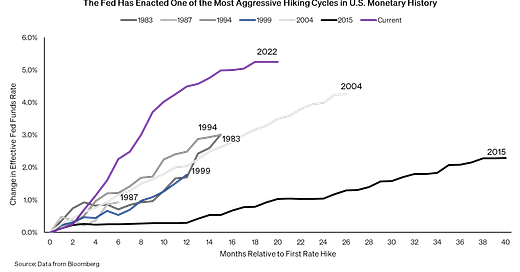Quick Essay: The Federal Reserve and Critical Moments in U.S. Monetary Policy
A short history
In 2021, the U.S. missed a once-in-a-generation opportunity to refinance its national debt at near zero-rates. With soaring interest rates and a looming debt storm approaching, the actions of the Treasury and Federal Reserve have never been more important. We decided to look back at the history of monetary policy from the establishment of the Federal Reserve in 1913 until today to put what’s happening into historical context.
Here’s the story:
1. The Need for a Central Bank
Before the creation of the Federal Reserve, the U.S. had a fragmented banking system that often faced financial and liquidity crises. Due to regional disparities in available funds and the absence of a central bank, transferring money from areas with surplus to those with deficits was challenging, hindering an effective response.
The Panic of 1907 exposed these systemic weaknesses. What began as two speculators failing to corner a copper mining stock led to widespread financial contagion as depositors fled the banks they feared could be exposed to losses. As the panic intensified, John Pierpont Morgan joined forces with other wealthy financiers to backstop the struggling banks.
Morgan's intervention highlighted the need for a robust solution to America's cyclical banking issues that didn’t rely on affluent individuals. The 1908 Aldrich-Vreeland Act and establishment of the 'National Monetary Commission' prompted a covert meeting on Jekyll Island in 1910, attended by some of America's leading financial minds, to devise a blueprint for a central banking system that could stabilize the currency and act as a lender of last resort.
2. The Birth of the Federal Reserve
After the meeting, Senator Nelson Aldrich (of the Aldrich-Vreeland Act) worked to formalize the plan and subsequently introduced it to Congress in 1912. While it was initially rejected due to fears of granting too much power to bankers, the election of Woodrow Wilson in 1912 brought a renewed focus on banking reform. In 1913, the Federal Reserve Act was signed into law, laying the foundations for a new central banking system.
The structure of the Federal Reserve was a delicate balancing act designed to accommodate public and private interests. Unlike other central banks around the world, the Federal Reserve isn’t just one central bank. It comprises 12 regional banks overseen by a central Board of Governors appointed by the President and confirmed by the Senate. This design helped to assuage concerns about centralized power and political control over the banking system.
3. The Great Depression
The early years of the Federal Reserve were marked by the 1929 stock market crash and the subsequent Great Depression, arguably the Fed’s most challenging period. A series of policy missteps, including raising interest rates to defend the dollar-gold peg instead of loosening monetary policy, deepened America’s economic woes.
Sweeping reforms to the Fed were introduced under FDR’s New Deal. The Banking Act of 1933 enforced the separation of commercial and investment banking, and established the FDIC to insure bank deposits. The Gold Reserve Act of 1934 gave the President the authority to change the gold value of the dollar, allowing for more flexible and expansionary monetary policy, and the Banking Act of 1935 gave the Board of Governors of the Federal Reserve authority over discount rates in each Federal Reserve district, instead of Reserve Banks setting rates themselves.
4. The Postwar Era and Bretton Woods
As WWII came to a close, economic leaders convened at Bretton Woods in New Hampshire to establish a new monetary system. At the center of this was the U.S. dollar. The Bretton Woods system pegged various currencies to the dollar, and pegged the dollar to U.S gold reserves at $35/ounce.
In the 1960s, the U.S. began to run an extensive balance of payments deficit, where the country’s total imports significantly exceeded exports. This was primarily due to overseas military spending for the Vietnam War, resulting in an increase in dollars held abroad. Other countries, particularly France, became skeptical about the U.S.’s ability to maintain its gold-dollar link given America’s growing dollar supply and public debt.
Concerned about potential devaluation of its dollar holdings, France began to exchange its dollar reserves for gold from the U.S. Treasury, precipitating a significant outflow of U.S. gold reserves as other countries followed suit. If the trend continued, America's gold reserves could be depleted, threatening the dollar's convertibility and potentially leading to a financial crisis.
The crisis culminated in 1971 when President Nixon shocked the world by announcing that the dollar would no longer be convertible into gold, marking the end of the Bretton Woods system and transitioning the world into an era of Fiat currency.
5. Financial Deregulation and the Tech Bubble
The 1980s and 1990s saw a wave of financial deregulation. The Gramm-Leach-Bliley Act of 1999 repealed many key provisions of the Banking Act of 1933 which separated commercial and investment banking activities, fueling greater integration in the financial services industry. Meanwhile, the late 1990s witnessed the tech bubble, highlighted as “irrational exuberance” by Fed Chairman Alan Greenspan as early as 1996. Instead of intervening at the time, the Fed opted to address the consequences of the bubble by responding with a wave of interest rate cuts to cushion the fallout.
6. The 21st Century
2008 was a defining moment for the Fed. What began as a subprime mortgage crisis in 2007 spiraled into a Global Financial Crisis by 2008. The Fed’s response ushered in a new era of zero-interest-rate policy (ZIRP) and quantitative easing (QE), where they purchased long-term securities to inject liquidity into the economy and keep interest rates low. This playbook was repeated and extended for the COVID-19 pandemic, where the Fed slashed interest rates to zero and extended QE to purchase blue-chip and junk bonds.
7. Quantitative Tightening
When met with pent up demand and supply chain shocks following COVID lockdowns, this expansionary monetary policy resulted in some of the highest inflation rates seen since the 1980s. In an attempt to quell this problem, the Fed enacted one of the most aggressive interest rate hiking cycles in U.S. monetary history. Since Q1 of 2022, the Federal Funds Rate has gone from near zero to more than 5%. This led to a precipitous decline in valuations for growth assets, especially in tech, biotech, SPACs, and virtually all other negative cash flow businesses.
Summary:
After recurring financial panics, notably in 1907, the U.S. established the Federal Reserve in 1913 to stabilize the banking system.
The Fed's early missteps worsened the Great Depression, leading to key reforms like the Banking Act which established the FDIC, and the Gold Reserve Act which relaxed the U.S. Dollar-Gold peg.
Post-WWII, the U.S. dollar was central in global finance, but rising debts and the Vietnam War expenditures led to gold outflows and the end of gold convertibility in 1971.
The late 20th century saw deregulation and the tech bubble, with the Fed adopting a reactive stance.
The 2008 Financial Crisis and COVID-19 saw the Fed introduce zero-interest-rate policy and quantitative easing.
Zero rates and pent up demand resulted in soaring inflation in 2022. The Fed responded with one one of the most aggressive interest rate hiking cycles in U.S. history.







Great stuff here Chamath.
I’d love to see a deep dive of why Congress does continuing resolutions for budget proposals vs how they’re supposed to be doing it as laid out by the law
You covered it briefly on the pod a few weeks ago but I would get a lot of value out of a concise article like this
Is the fed in the arena?